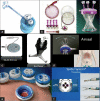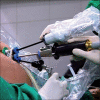Single-incision laparoscopic surgery - current status and controversies
- PMID: 21197236
- PMCID: PMC3002008
- DOI: 10.4103/0972-9941.72360
Single-incision laparoscopic surgery - current status and controversies
Abstract
Scarless surgery is the Holy Grail of surgery and the very raison d'etre of Minimal Access Surgery was the reduction of scars and thereby pain and suffering of the patients. The work of Muhe and Mouret in the late 80s, paved the way for mainstream laparoscopic procedures and it rapidly became the method of choice for many intra-abdominal procedures. Single-incision laparoscopic surgery is a very exciting new modality in the field of minimal access surgery which works for further reducing the scars of standard laparoscopy and towards scarless surgery. Natural orifice translumenal endoscopic surgery (NOTES) was developed for scarless surgery, but did not gain popularity due to a variety of reasons. NOTES stands for natural orifice translumenal endoscopic surgery, a term coined by a consortium in 2005. NOTES remains a research technique with only a few clinical cases having been reported. The lack of success of NOTES seems to have spurred on the interest in single-incision laparoscopy as an eminently doable technique in the present with minimum visible scarring, rendering a 'scarless' effect. Laparo-endoscopic single-site surgery (LESS) is, a term coined by a multidisciplinary consortium in 2008 for single-incision laparoscopic surgery. These are complementary technologies with similar difficulties of access, lack of triangulation and inadequate instrumentation as of date. LESS seems to offer an advantage to surgeons with its familiar field of view and instruments similar to those used in conventional laparoscopy. LESS remains a evolving special technique used successfully in many a centre, but with a significant way to go before it becomes mainstream. It currently stands between standard laparoscopy and NOTES in the armamentarium of minimal access surgery. This article outlines the development of LESS giving an overview of all the techniques and devices available and likely to be available in the future.
Keywords: E-NOTES; LESS; single-incision laparoscopy; single-port access.
Conflict of interest statement
Figures















References
-
- Mouret P. How I developed laparoscopic cholecystectomy. Ann Acad Med Singapore. 1996;25:744–7. - PubMed
-
- Kalloo AN, Singh VK, Jagannath SB, Niiyama H, Hill SL, Vaughn CA, et al. Flexible transgastric peritoneoscopy: A novel approach to diagnostic and therapeutic interventions in the peritoneal cavity. Gastrointest Endosc. 2004;60:114–7. - PubMed
-
- Gettman MT, Lotan Y, Napper CA, Cadeddu JA. Transvaginal laparoscopic nephrectomy: Development and feasibility in the porcine model. Urology. 2002;59:446–50. - PubMed
LinkOut - more resources
Full Text Sources
